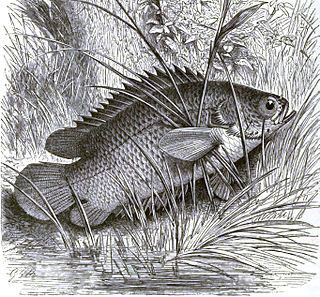
The Anabantidae are a family of ray-finned fish within the order Anabantiformes commonly called the climbing gouramies or climbing perches. The family includes about 34 species. As labyrinth fishes, they possess a labyrinth organ, a structure in the fish's head which allows it to breathe atmospheric oxygen. Fish of this family are commonly seen gulping at air at the surface of the water. The air is held in a structure called the suprabranchial chamber, where oxygen diffuses into the bloodstream via the respiratory epithelium covering the labyrinth organ. This therefore allows the fish to move small distances across land.

Rasbora is a genus of fish in the family Cyprinidae. They are native to freshwater habitats in South and Southeast Asia, as well as southeast China. A single species, R. gerlachi, is only known from an old specimen that reputedly originated from Africa (Cameroon), but this locality is considered doubtful. They are small, up to 17 cm (6.7 in) long, although most species do not surpass 10 cm (4 in) and many have a dark horizontal stripe.

Oreochromis is a large genus of oreochromine cichlids, fishes endemic to Africa and the Middle East. A few species from this genus have been introduced far outside their native range and are important in aquaculture. Many others have very small ranges; some are seriously threatened, and O. ismailiaensis and O. lidole possibly are extinct. Although Oreochromis primarily are freshwater fish of rivers, lakes and similar habitats, several species can also thrive in brackish waters and some even survive in hypersaline conditions with a salinity that far surpasses that of seawater. In addition to overfishing and habitat loss, some of the more localized species are threatened by the introduction of other, more widespread Oreochromis species into their ranges. This is because they—in addition to competing for the local resources—often are able to hybridize.

Lamprologus is a genus of fishes from the cichlid family. They are native to Lake Tanganyika and the Congo River Basin in Africa. The type species for this genus is Lamprologus congoensis, a species from the Congo River. The genus is under some revision and may eventually be restricted to these riverine types.

Labeo is a genus of carps in the family Cyprinidae. They are found in freshwater habitats in the tropics and subtropics of Africa and Asia.

Rhamphochromis is a genus of East African haplochromine cichlids endemic to the Lake Malawi basin, also including Lake Malombe, Lake Chilingali, Chia Lagoon and upper Shire River. They mainly occur in offshore open waters, but a few species also near the coast. They are piscivores that typically feed on lake sardines and small utaka cichlids.
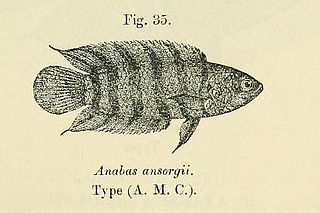
Microctenopoma ansorgii is a small freshwater fish, known in the aquarium trade as the ornate ctenopoma, orange ctenopoma, ornate climbing perch, pretty ctenopoma, or rainbow ctenopoma. It is related to the more familiar spotted climbing perch, but looks very different. Its body is more elongated and rounded, with fins with red and black stripes; the color intensifies when the fish are displaying, with black bars becoming visible on the body. The ornate ctenopoma spawns at night, laying its eggs on a floating bubble nest like its relatives in the osphronemidae. It lives in the slow-flowing forest streams of the Congo Basin, where it feeds on worms, insect larvae, and other aquatic invertebrates. It is the most common member of its genus in the aquarium trade, where it is known for being a shy, easily bullied fish that needs live or frozen foods and which benefits from the presence of smaller dither fish to encourage it to come out of hiding.

Raiamas is a genus of cyprinid freshwater fishes. The majority of the species are from Africa, but R. bola and R. guttatus are from South and Southeast Asia.
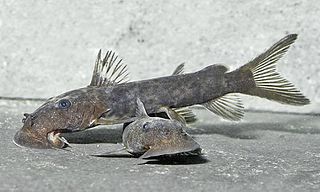
Euchilichthys is a genus of upside-down catfishes native to the Congo River Basin in Middle Africa.

Brycinus is a genus of ray-finned fish in the family Alestiidae. Like other "African characids", they were formerly included in the Characidae but are actually somewhat more distantly related Characiformes.

Distichodus is a genus of freshwater fish in the family Distichodontidae found in Africa.

Hippopotamyrus is a genus of elephantfish in the family Mormyridae.

Pollimyrus is a genus of elephantfishes native to Africa.
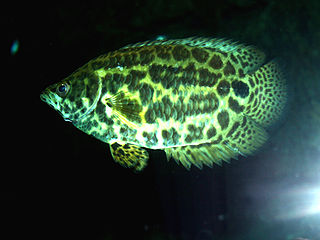
Ctenopoma is a genus of climbing gouramies native to Africa. Microctenopoma has been included in Ctenopoma in the past; in contrast to that genus, Ctenopoma species are egg scatterers with no parental care.

Ctenopoma multispine, known as the many-spined ctenopoma or climbing perch, is an African freshwater fish. It is up to 14 cm (5.5 in) long and occurs in the Lufira River, Lualaba River, Upemba River, Luapula-Moero in the Democratic Republic of the Congo, Upper Zambezi in Zambia and Okavango River-Lake Ngami in Angola and Botswana. It is also known from the Kafue, rivers of coastal Mozambique, Cuanza River in Angola, and southern tributaries of the Congo River system.

Microctenopoma nanum, the dwarf ctenopoma, is a fish in the family Anabantidae found in southern Cameroon, Gabon, and the Congo Basin of Africa. It grows to 8.0 cm in total length.
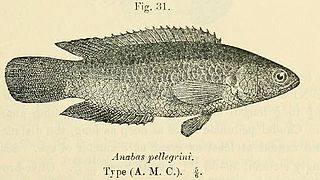
Ctenopoma pellegrini is a fish in the family Anabantidae found in the Congo River basin of Africa. It grows to 11.2 cm in total length for a male/unsexed specimen. This species was formally described by the British-Belgian ichthyologist George Albert Boulenger in 1902 with the type locality given as Yembe River at Banzyville in the Democratic Republic of Congo. Boulenger honoured the French ichthyologist Jacques Pellegrin (1873-1944).
Microctenopoma ocellifer is a fish in the family Anabantidae found in the Congo River basin of Africa. It grows to 5.4 cm in total length.
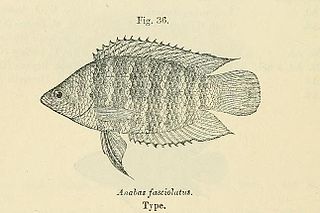
Microctenopoma fasciolatum or the banded bushfish is an Anabantoid fish of the genus Microctenopoma. It is native to the Republic of Congo, the Democratic Republic of Congo and a few rivers in Cameroon, occurring in the lower and central parts of the Congo River. This species has numerous irregular dark stripes running vertically across its body, with a horizontal lighter stripe separating them. The banding becomes more pronounced as the fish ages. In males, the dorsal and annal fins are more pointed, and - in some populations - have bright iridescent blue spots. This species, like many related anabantoids lays its approximately 1000 eggs into a bubble nest. This fish grows to a size of 9 cm (3.5 in).

The Anabantiformes are an order of freshwater ray-finned fish with two suborders, five families and having at least 207 species. In addition, some authorities expand the order to include the suborder Nandoidei, which includes three families - the Nandidae, Badidae and Pristolepididae - that appear to be closely related to the Anabantiformes. The order, and these three related families, are part of a monophyletic clade which is a sister clade to the Ovalentaria, the other orders in the clade being Synbranchiformes, Carangiformes, Istiophoriformes and Pleuronectiformes. This clade is sometimes referred to as the Carangaria but is left unnamed and unranked in Fishes of the World. This group of fish are found in Asia and Africa, with some species introduced in United States of America.



















